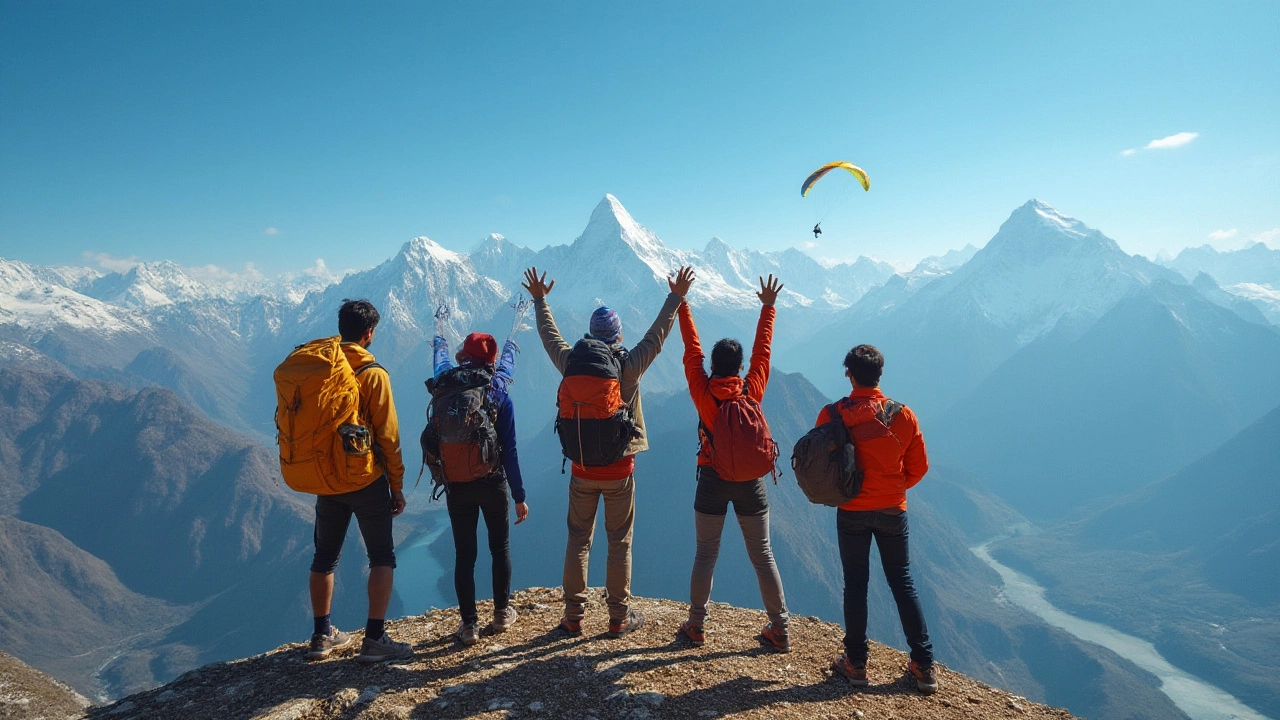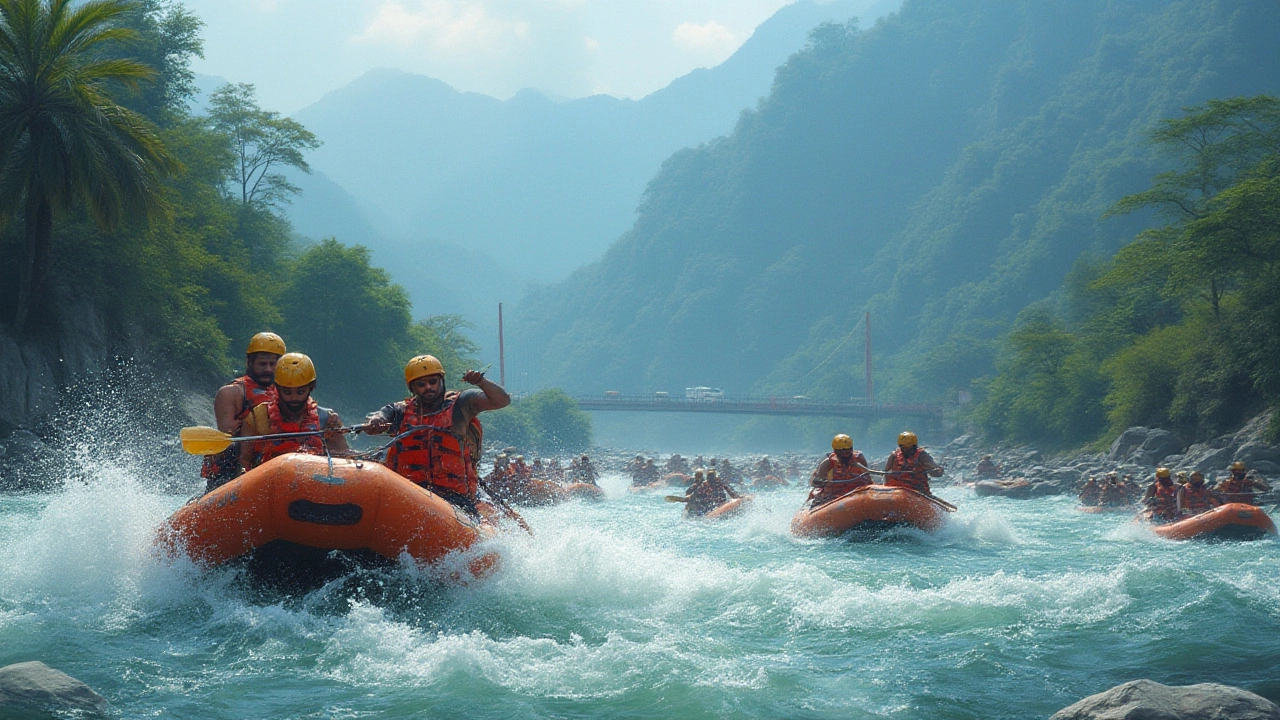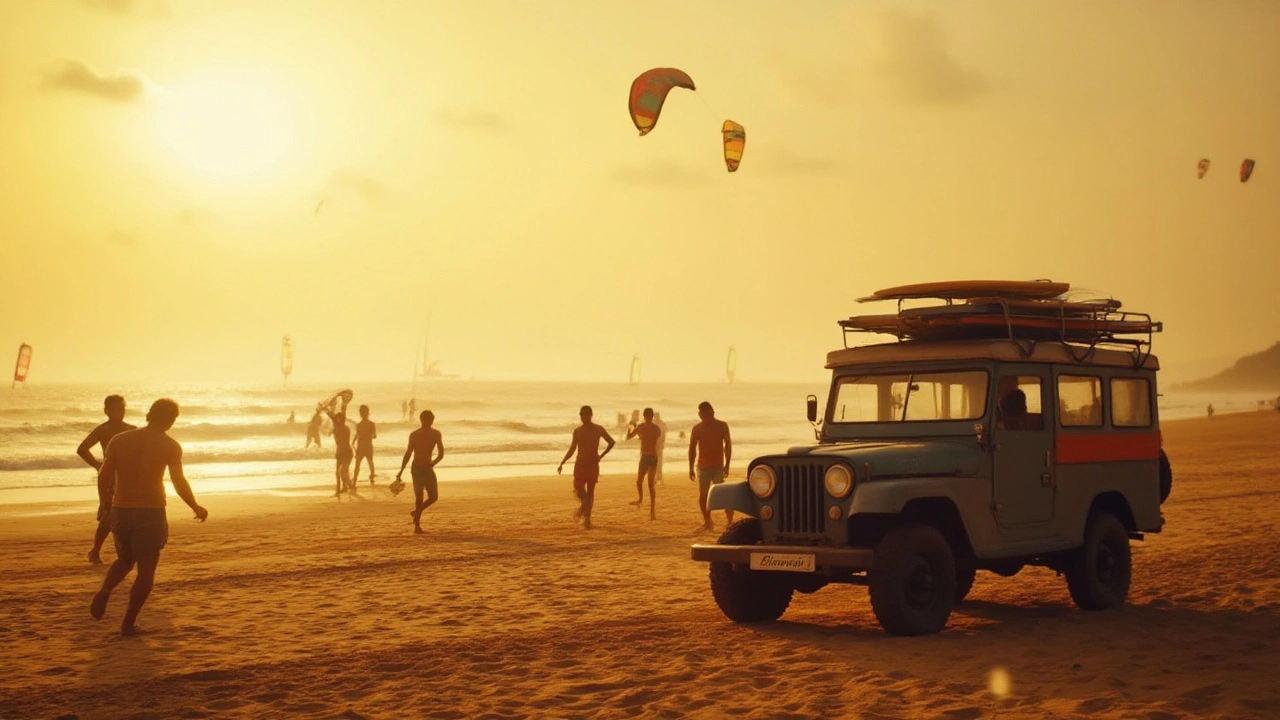Best Places for Adventure Sports in India: Top Destinations, Activities & Tips
 Jul, 15 2025
Jul, 15 2025
Cliff-jumping into turquoise rapids, paragliding with the wind brushing your face, or balancing on a slackline over a high Himalayan valley—sound like your thing? India is not just about sprawling palaces and spicy street food. If you want your heart racing and your veins pulsing with adrenaline, this is exactly the country to challenge yourself. India’s raw beauty means wild peaks, surging rivers, and endless coastline—all a playground for adventure junkies. But which place takes the crown for the best adventure sports in India? Truth is, it’s not that simple. This country is massive and diverse, so let’s break it down and help you choose your adventure haven.
North India: Where Mountains Mean Serious Adrenaline
Picture this: snow-dusted mountains, giddy heights, and enough adventure sports to test the guts of even the bravest. North India, home to the Himalayas, is where the real thrill-seekers flock. Manali sits at the top of every adrenaline wishlist, especially if paragliding is on your bucket list. Solang Valley near Manali is basically a launchpad—for you and your fears. It’s one of the world’s most scenic places to take flight, with peaks soaring to over 13,000 feet. Most operators here are seasoned pros, but always check their licenses and see recent reviews before strapping in.
Kullu is rafting central, with the Beas River offering Grade II and III rapids. Even first-timers leave grinning ear to ear, while seasoned rafters keep coming back for the rush. Between May and June, when the snows melt, this area comes alive with paddlers. For a higher-throttle fix, try Zanskar River rafting in Ladakh—that’s for those who want wild, freezing, and remote, with steep gorges and sapphire waters.
Ever thought about skiing in India? Gulmarg in Kashmir puts many European slopes to shame when it comes to powder and scenery. Lift passes here are way more affordable and there’s a buzzing camaraderie among travelers. Adventure outfitters also offer heli-skiing—imagine hopping out of a helicopter onto untouched slopes. There’s a catch: weather is fickle, and slopes can close at short notice for safety. Always have a backup plan, like snowboarding or snowshoeing.
Mountaineering and trekking also deserve the spotlight. Ladakh, Spiti, and Uttarakhand are the go-tos, offering jaw-dropping routes like the Stok Kangri climb or the Chadar Trek (walking on the frozen Zanskar river). Here, the weather gods rule—you’ll need flexibility and a tolerance for the unexpected. If it’s altitude sickness you fear, acclimatize in stages and listen to your body. The Himalayas won’t go easy on anyone in a rush.
For something a little different, try mountain biking routes in Himachal and Uttarakhand. The Manali-Leh highway is infamous in the biking world—a punishing test for riders, but those landscapes will absolutely repay the effort. Make sure your fitness (and your bike) are up to it, and don’t underestimate how remote these places can get. Carry spares, a basic toolkit, and some cash: ATMs outside towns are scarce.
Altitude, cold weather, unpredictable conditions—adventure here is always about being prepared rather than winging it. Before you go, check reputable weather apps, consult local guides about the season’s risks, and always let someone know your plan. Most of all: pace yourself. The Himalayas reward patience.
West India: Rushing Rivers and Wild Rides
Don’t let the dry hills of western India fool you. Maharashtra and Goa offer some pretty incredible options for those who want the adventure without the high-altitude headaches. Dandeli, in Karnataka but bordering Goa, is a magnet for anyone who loves white-water rafting. The Kali River dishes out strong rapids but also wide, lazy stretches if you want to take it slow. Kayaking and canoeing are also making a splash here, so you can swap paddles if your arms are up for it.
The Western Ghats, declared a UNESCO World Heritage site, snake across the west and are packed with biodiversity. During monsoons, the Sahyadri hills come alive. Trekking here is wild, lush, and often slippery—Harishchandragad, Rajmachi, and the mighty Torna forts are popular among local trekkers. Waterfall rappelling becomes a rainy-season favourite, with spots like Vihigaon and Bhivpuri drawing daredevils who want to abseil through thundering water.
For those who love wheels, the Western Ghats serve up nearly 600 km of winding mountain roads. Bikers from Mumbai and Pune roar their way to Lonavala, Mahabaleshwar, and Malshej Ghat on weekends. The trick here is timing: go early to avoid crowds, especially during monsoon, and keep an eye out for sudden landslides. Pack waterproof gear and extra snacks—they’re lifesavers on long rides.
If you’re more into the sea, then Goa’s got your fix. Visit between October and April and you’ll find every kind of water sport imaginable: windsurfing, parasailing, jet skiing, scuba diving, kiteboarding—you name it. The best beaches for action are Calangute, Baga, and Palolem. Scuba diving in Goa may not rival the Andamans’ coral but it’s accessible and great for beginners. Several operators have PADI certification and run courses for those who want to get serious about diving.
Looking for big stops in data? Here’s a taste—more than 120,000 tourists try adventure sports in Goa every high season. Paragliding in Kamshet has been featured in “Lonely Planet’s Top Ten” for tandem flights, and Dandeli’s Kali river welcomes thousands of white-water rafting enthusiasts each year.
| Spot | Main Sport | Best Season | Skill Level |
|---|---|---|---|
| Dandeli | White-water Rafting | Oct-Mar | Beginner-Intermediate |
| Kamshet | Paragliding | Oct-Jun | Beginner-Advanced |
| Goa | Scuba Diving, Windsurfing | Oct-Apr | Beginner-Intermediate |
Best tip: Always double-check the safety track record of operators before booking. Look for certifications, read traveler forums, and don’t compromise on gear.

East India: Wild Jungles, River Thrills, and Hidden Treasures
The eastern corner of India is an unpolished gem when it comes to adventure. Most travelers miss this bit entirely, which means fewer crowds and more wild. Arunachal Pradesh, Sikkim, and Meghalaya are loaded with secret treks, living root bridges, zip-lining, caving, and even hot air ballooning above endless green hills. Ever heard of Mawlynnong—the cleanest village in Asia? It’s smack in the middle of Meghalaya and the jumping-off point for insane living-root bridge hikes. These aren’t your garden-variety treks: think knee-deep humid jungles, wobbly stone paths, and climbs that’ll leave you breathless in two senses.
For white-water lovers, the Teesta and Rangit rivers in Sikkim are legendary. Teesta’s rapids can go up to Grade IV, especially after monsoon, so locals always say: respect the river. Operators here tend to keep things simple (think basic rafts and oars), so pick only those with solid safety records. Sikkim also opens doors to mountain bikers, with routes from Gangtok to Phodong.
Head further south, and you’ll find Odisha’s Satkosia Gorge—nearly untouched and wild, perfect if kayaking or canoeing is your jam. March to June and October-November are the best windows. There are rare glimpses of gharials (fish-eating crocodiles) and migratory birds along the banks, so keep your cameras handy but don’t lean too far out of the boat.
Jamshedpur in Jharkhand is the new hub for rock climbing. Dalma Hills serve up excellent bouldering and technical climbing routes, especially during winter when conditions are dry. Local climbing clubs usually welcome visitors and often share their gear and routes. Just don’t expect posh amenities—carry your own snacks, water, first-aid, and chalk.
Plan to spend more time and expect spartan infrastructure. Most remote areas will have basic homestays, spotty reception, and cash-only payments. But that’s part of the thrill—you’re literally off the grid. Guides in these regions tend to be born adventurers, raised among steep slopes and slippery jungle paths, so tap into their stories and suggestions.
Hot tip for east India: Pack for rain, mud, and leeches (yes, really). Good boots and salt are your best friends. And be ready for sudden plans—sometimes the most memorable adventure happens when you least expect it.
South India: Oceans, Hills, and Underwater Dreams
South India pulls in a different crowd. Here, salty wind and coconut trees set the tone, but the action is anything but laid back. The Andaman Islands have quietly become India’s diving mecca, and Havelock Island is the prime launchpad. Visibility here can reach up to 50 meters in the best season (Nov-Apr), and if you’re lucky, you’ll be grinning at manta rays, turtles, and gliding barracudas. PADI and SSI operators are easy to find, but book in advance, especially during Christmas and New Year. Diving here is for beginners to advanced, but even non-swimmers can try introductory dives—with a certified instructor, of course.
Surfing is another biggie. Kovalam in Kerala, Varkala, and Mahabalipuram are hotspots for riders craving a taste of the Indian swell. June to September is when the waves are at their best. Worth knowing: Surfing culture is growing but it’s still pretty chilled out. Board rentals are cheap, but experienced surfers often bring their own gear. You can also sign up for lessons (usually about ₹1,000–2,000 per session).
If you prefer high-altitude adventure, Munnar and Coorg in Karnataka have become favorites with trekkers and mountain bikers. The Nilgiri Biosphere Reserve offers trails cutting through tea estates and rare Shola forests—get your camera ready for Malabar giant squirrels and troop after troop of monkeys.
The Western Ghats don’t just wind through Maharashtra—they stretch all the way into Tamil Nadu and Kerala, with hundreds of waterfalls perfect for canyoning. Monsoon brings an extra challenge: slippery rocks, rapid water flows, and muddy paths.
One thing to keep in mind: the wildlife. South India’s forests mean encounters with elephants, leopards, and snakes (sometimes on treks), so stay alert and trek with locals who know the territory. If you’re driving between adventure hubs, roads can get twisty—motion-sickness pills help, especially if you don’t have the steadiest stomach.
Best time to visit the south for adventure sports depends on what you’re chasing. December to April is great for scuba, October to May for trekking before the big rain hits, and June-September is prime surfing season. Don’t forget sunscreen—this region gets blazing hot, even on cloudy days.

How to Choose the Best Adventure Spot for You?
So, which spot wins for adventure sports in India? You probably saw this coming: it’s not one place, it’s a mashup of what you crave. Want a vivid table of options? Here you go:
| Region | Main Attractions | Best Season | Unique Tip |
|---|---|---|---|
| North India | Paragliding, Rafting, Trekking, Skiing | May-Oct, Dec-Mar | Acclimatize for altitude! |
| West India | Rafting, Paragliding, Biking, Water sports | Oct-Apr | Early starts avoid crowds |
| East India | Trekking, Caving, River Rafting | Oct-May | Packed for wet weather & leeches |
| South India | Scuba, Surfing, Canyoning, Trekking | Oct-Apr | Beware wildlife & pack sunscreen |
Set your priorities: Is it mountain air or salty sea breeze? Are you a first-timer or do you want something wild and technical? Traveling solo, with a group, or with family? Manali and Rishikesh are great for social groups and solo trips, while Andamans or East India offer a quieter, more offbeat vibe. If you’re all about adventure sports India, trek the Himalayas or dive into Andaman’s blue. For those tight on budget, the Western Ghats are loaded with day trips and wallet-friendly options.
- Always use reputable guides or certified companies for gear-heavy sports like diving, rafting, or paragliding.
- Travel insurance covering adventure sports is worth the extra rupees—seriously.
- Pack light but don’t skip essentials (layers for cold, full-sleeves for bugs, waterproofing for monsoon).
- Plan buffer days for “just-in-case” weather drama, especially in the mountains or during monsoon.
India’s astonishing diversity means you’ll never run out of challenges to conquer. Every part of this country has a unique flavor of adventure—from snow-dusted ridges in the far north to deep blue sea caves in the far south. So, grab your pack, shake off the hesitation, and dive into your next adventure—no matter which wild corner of India you choose to chase the thrill in.